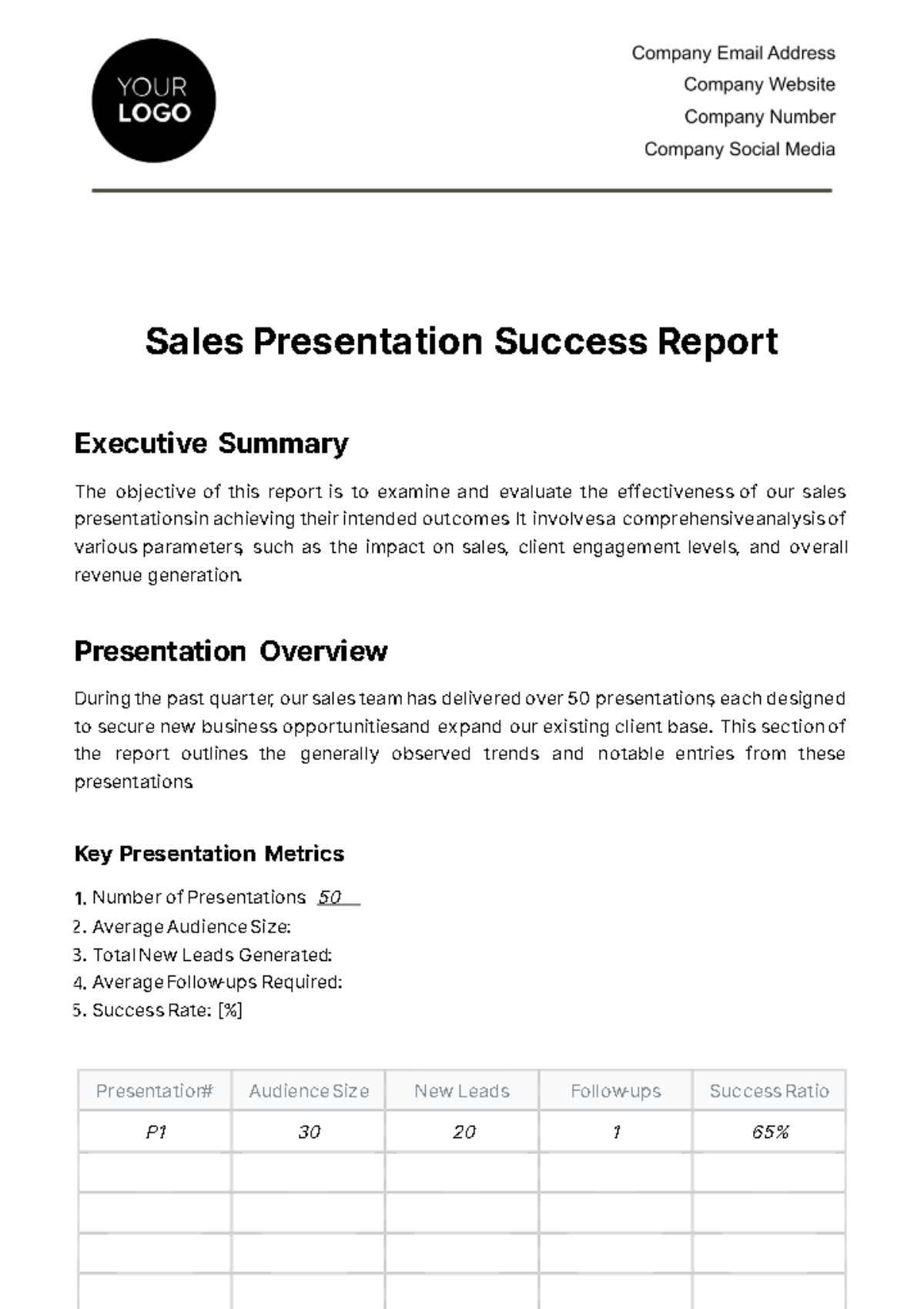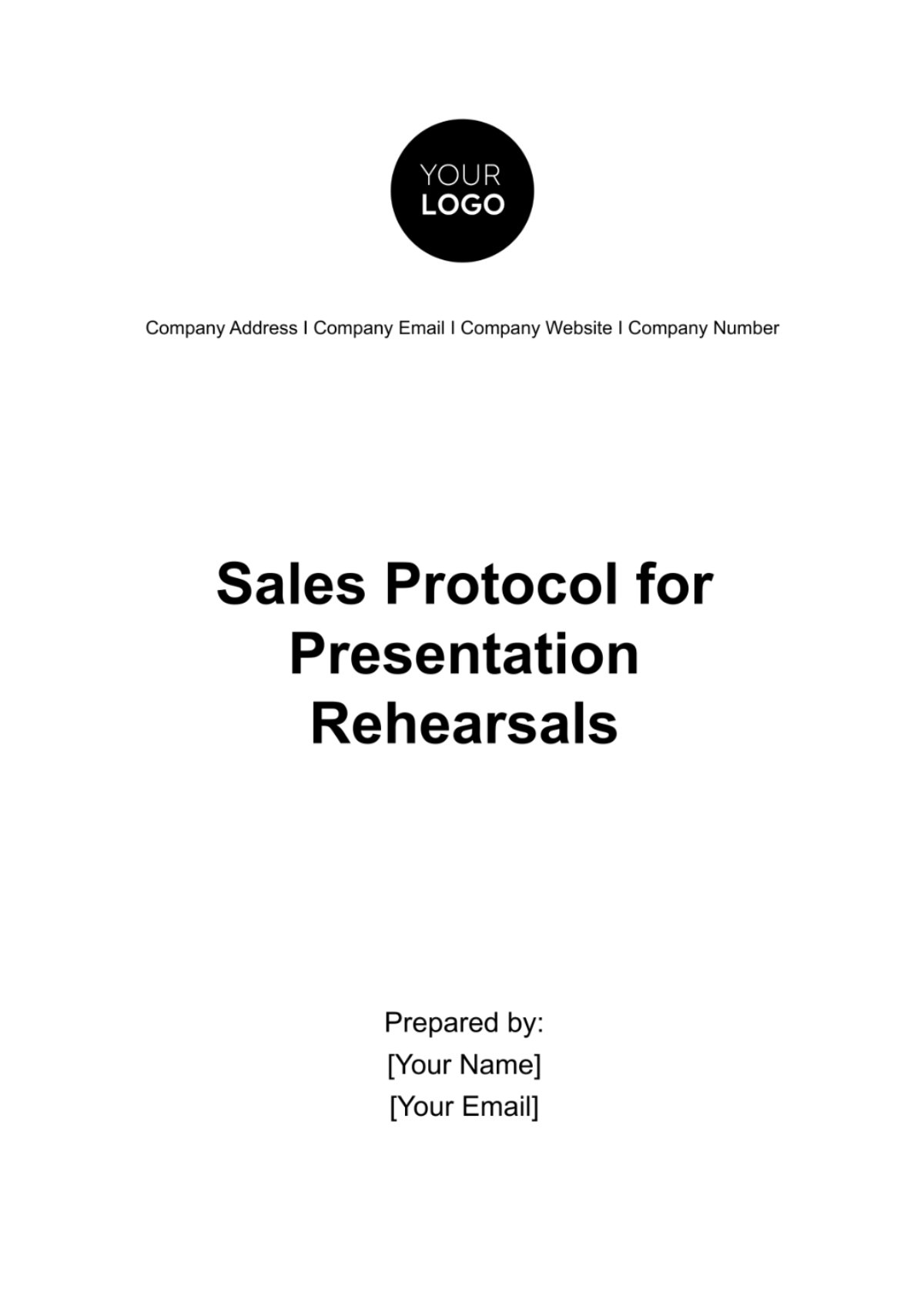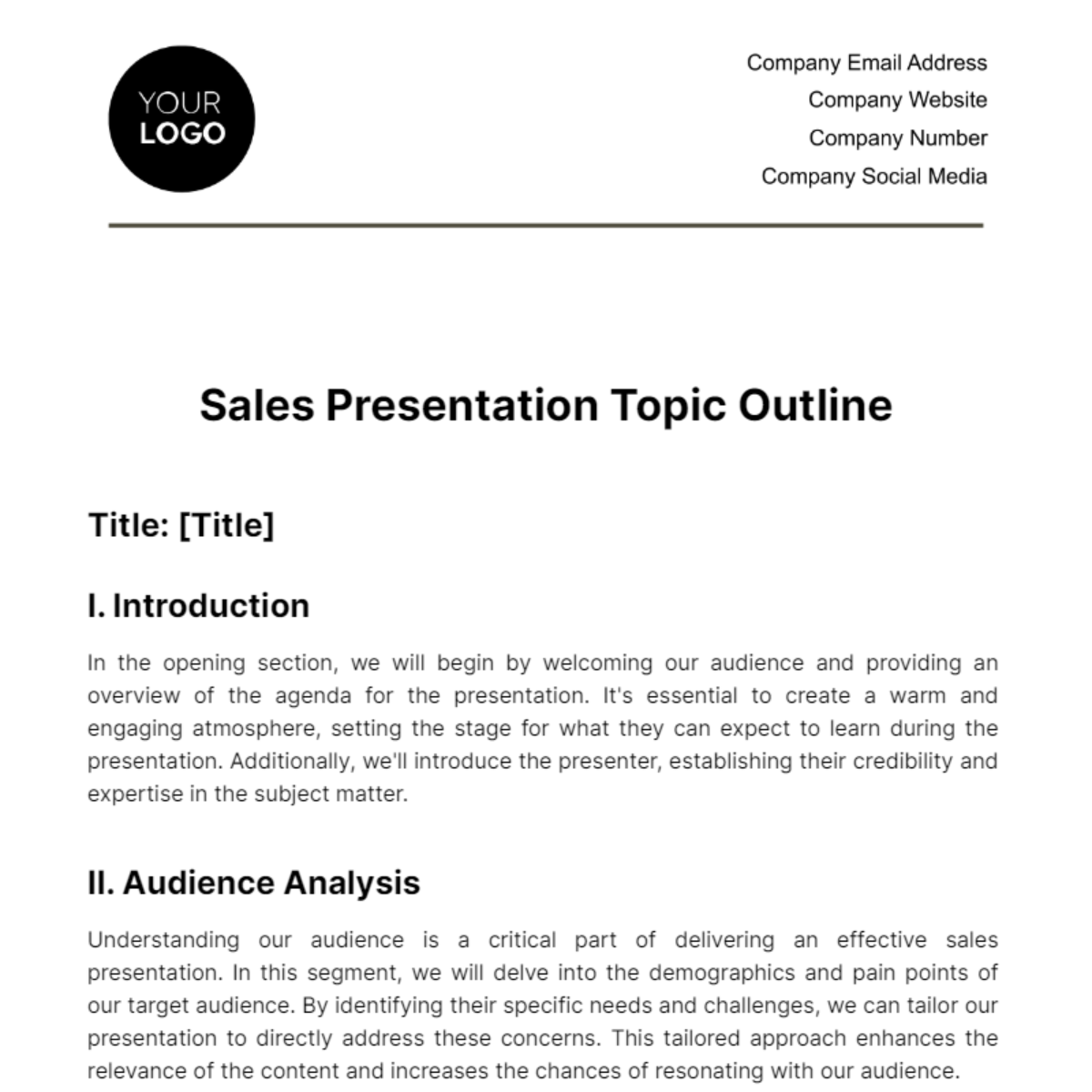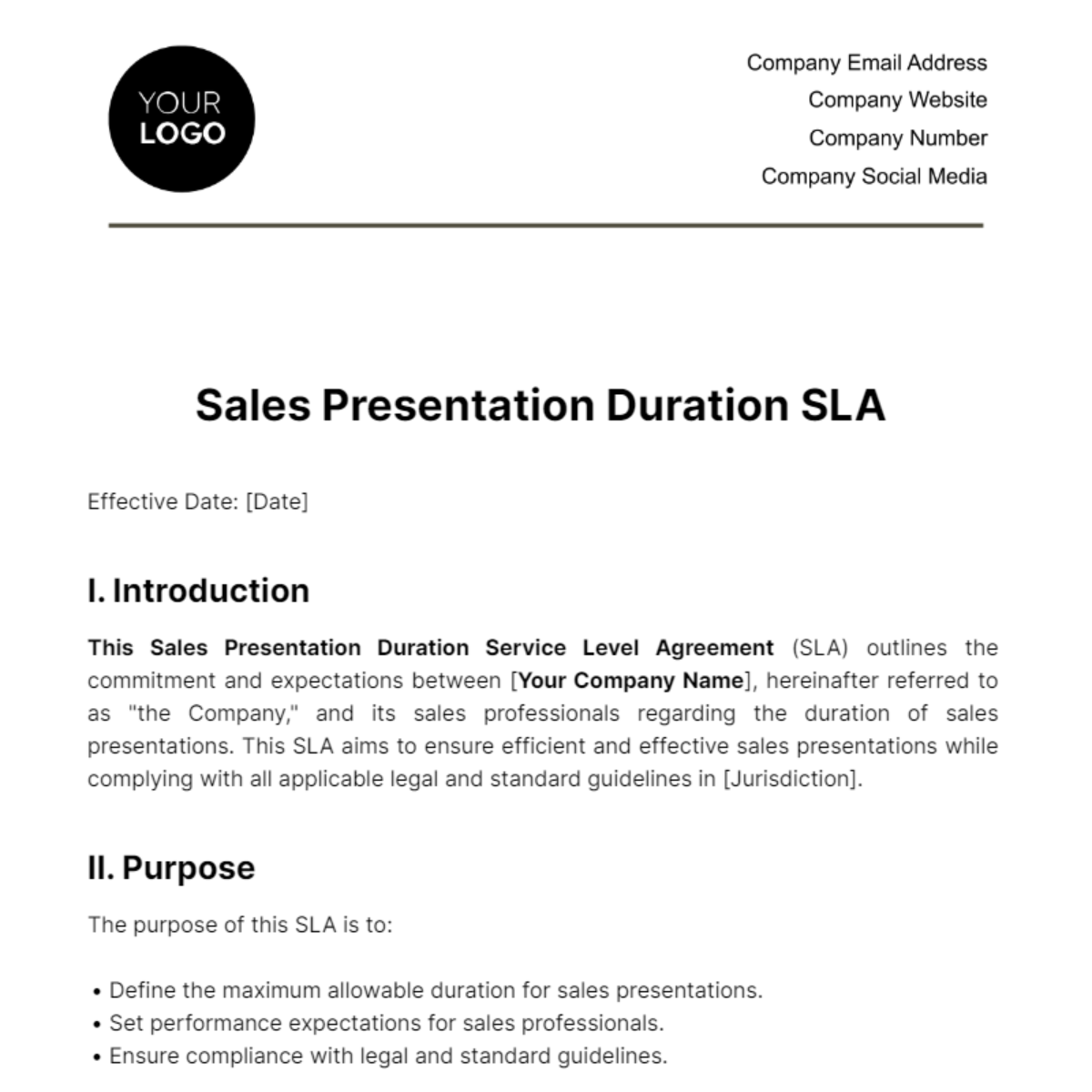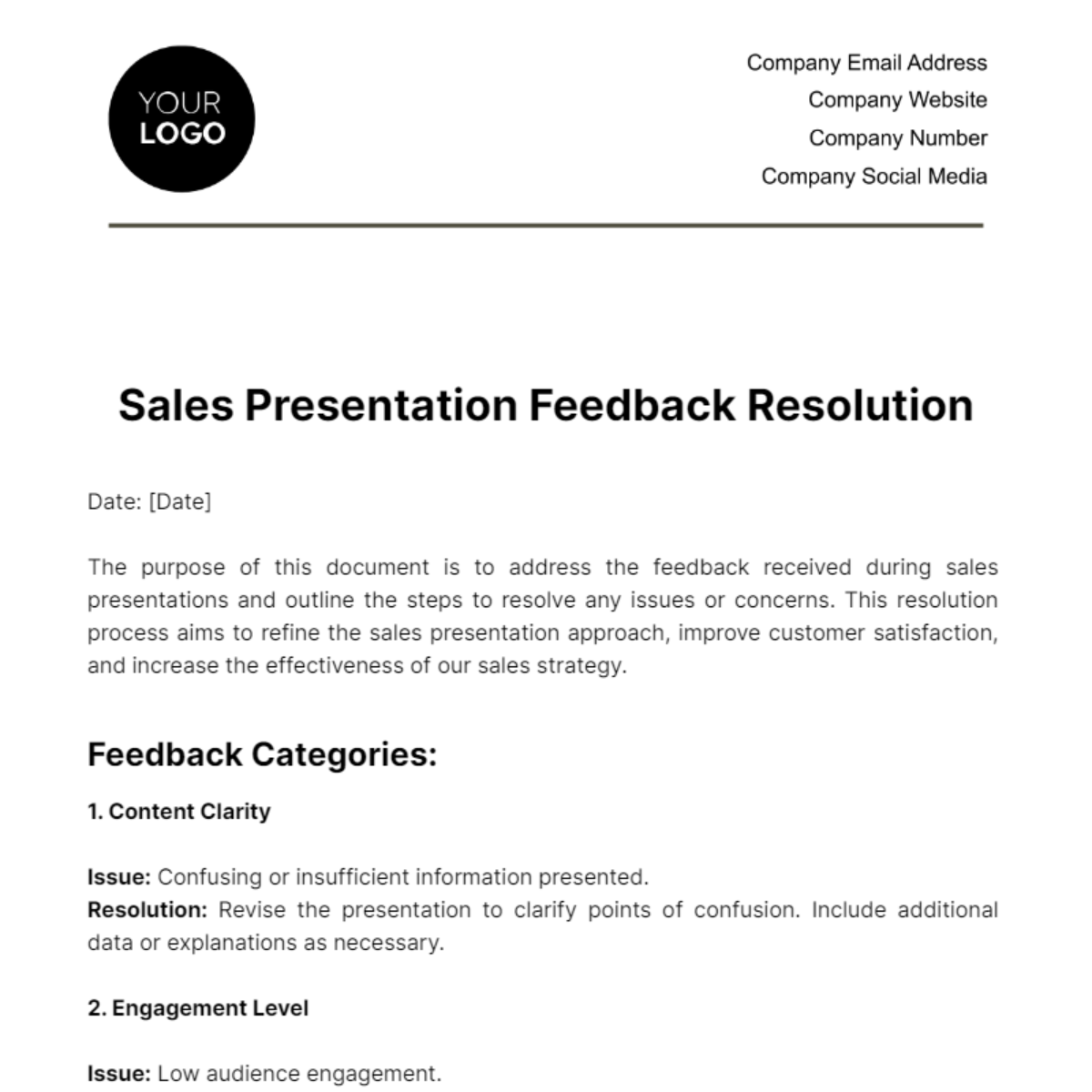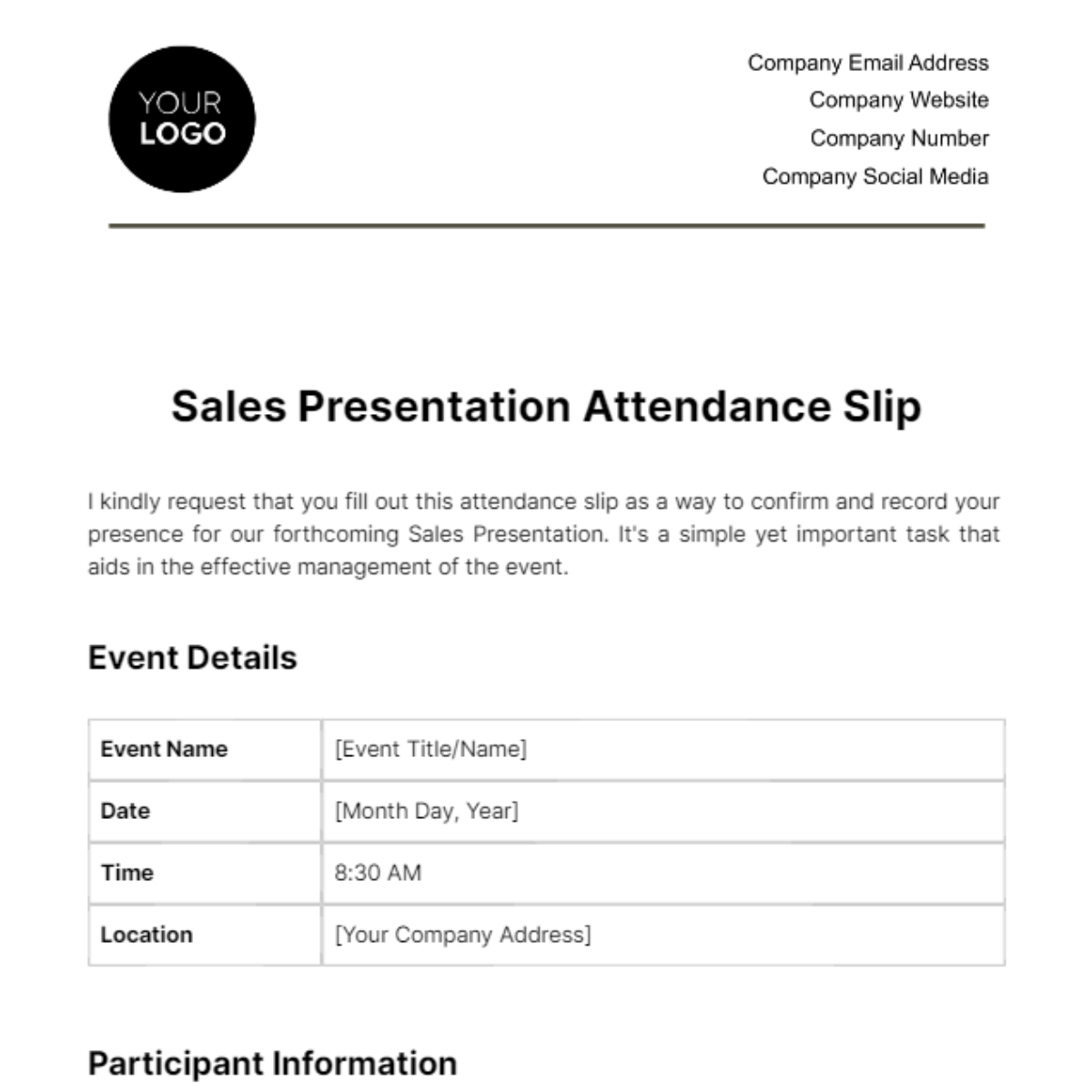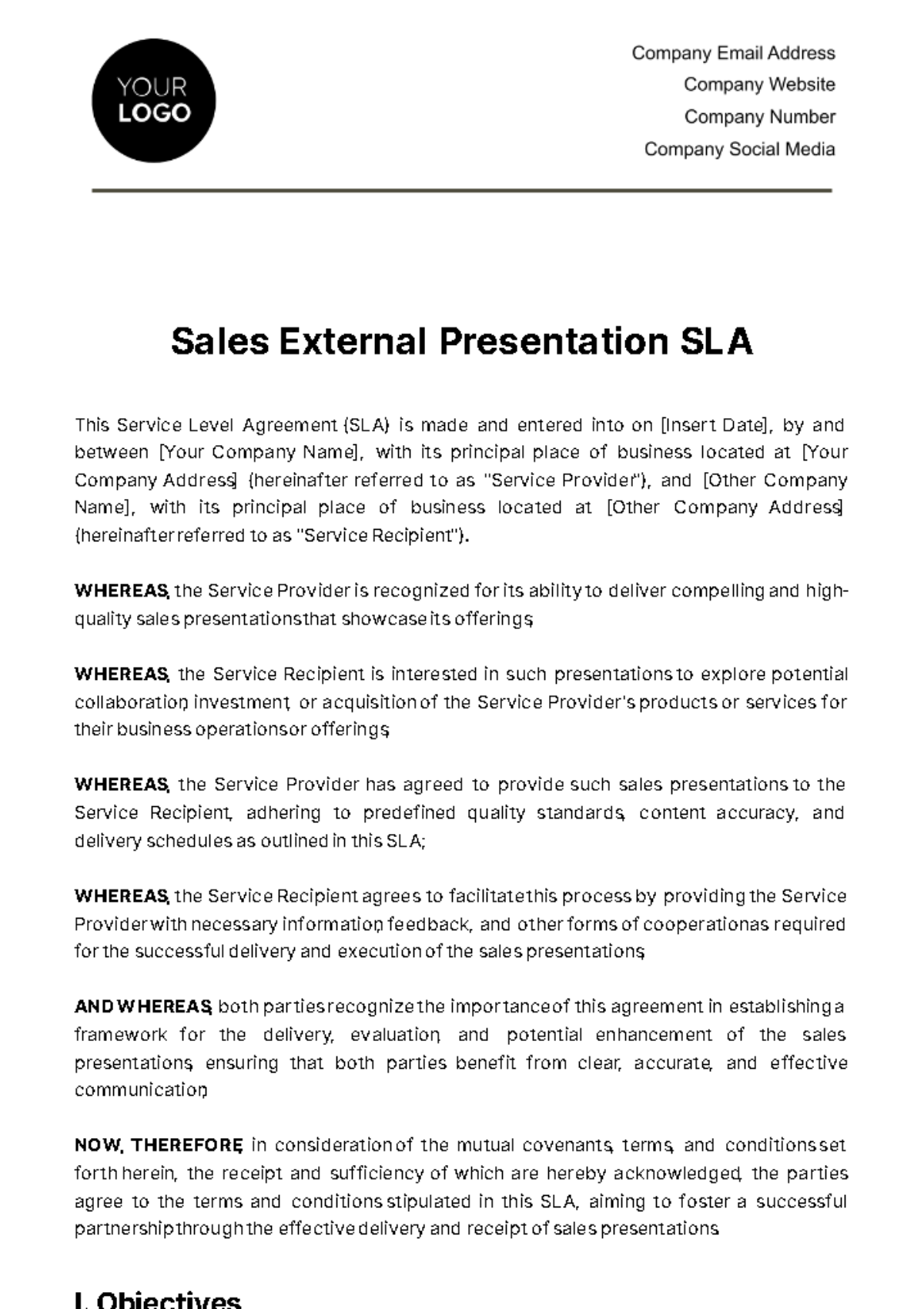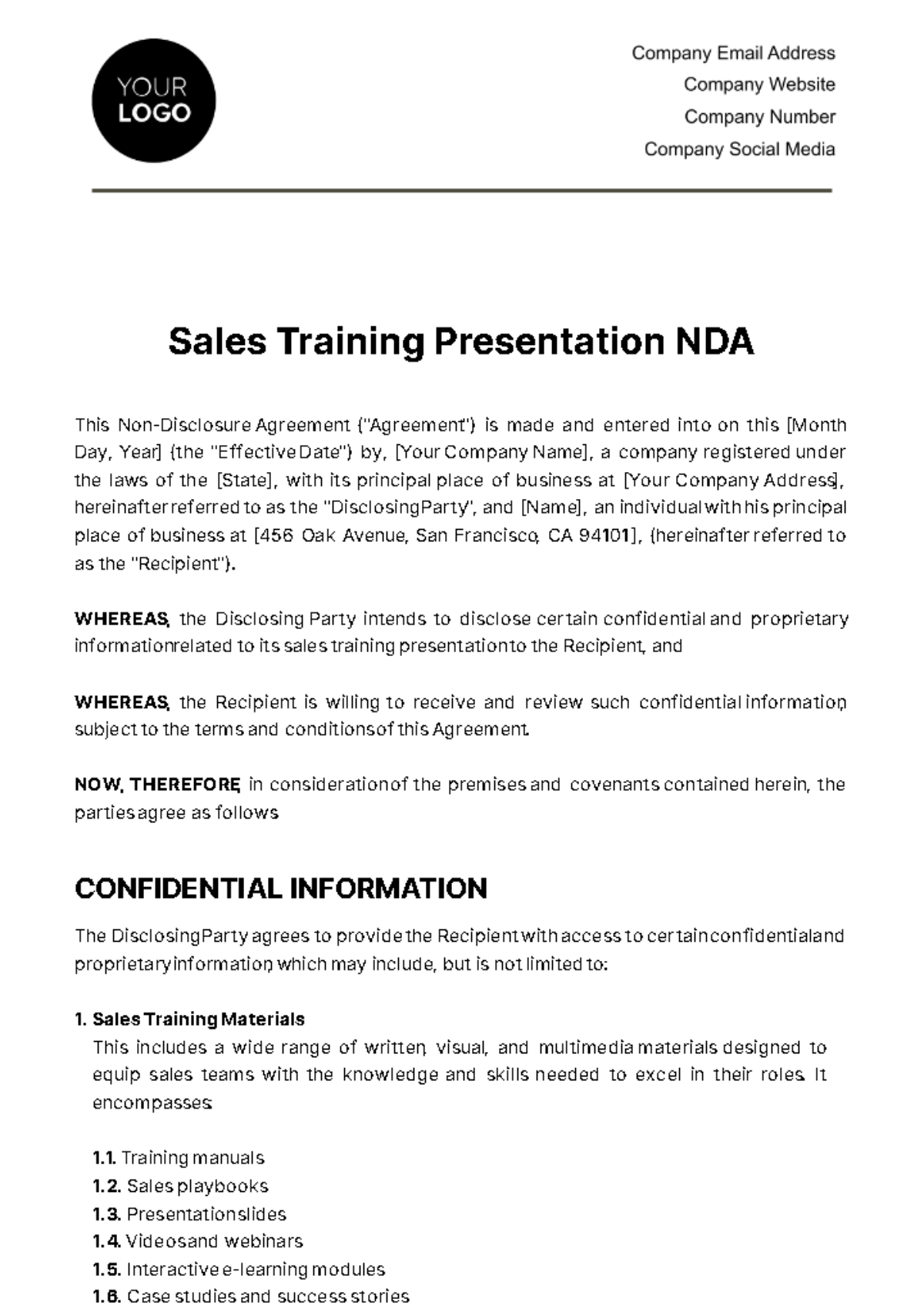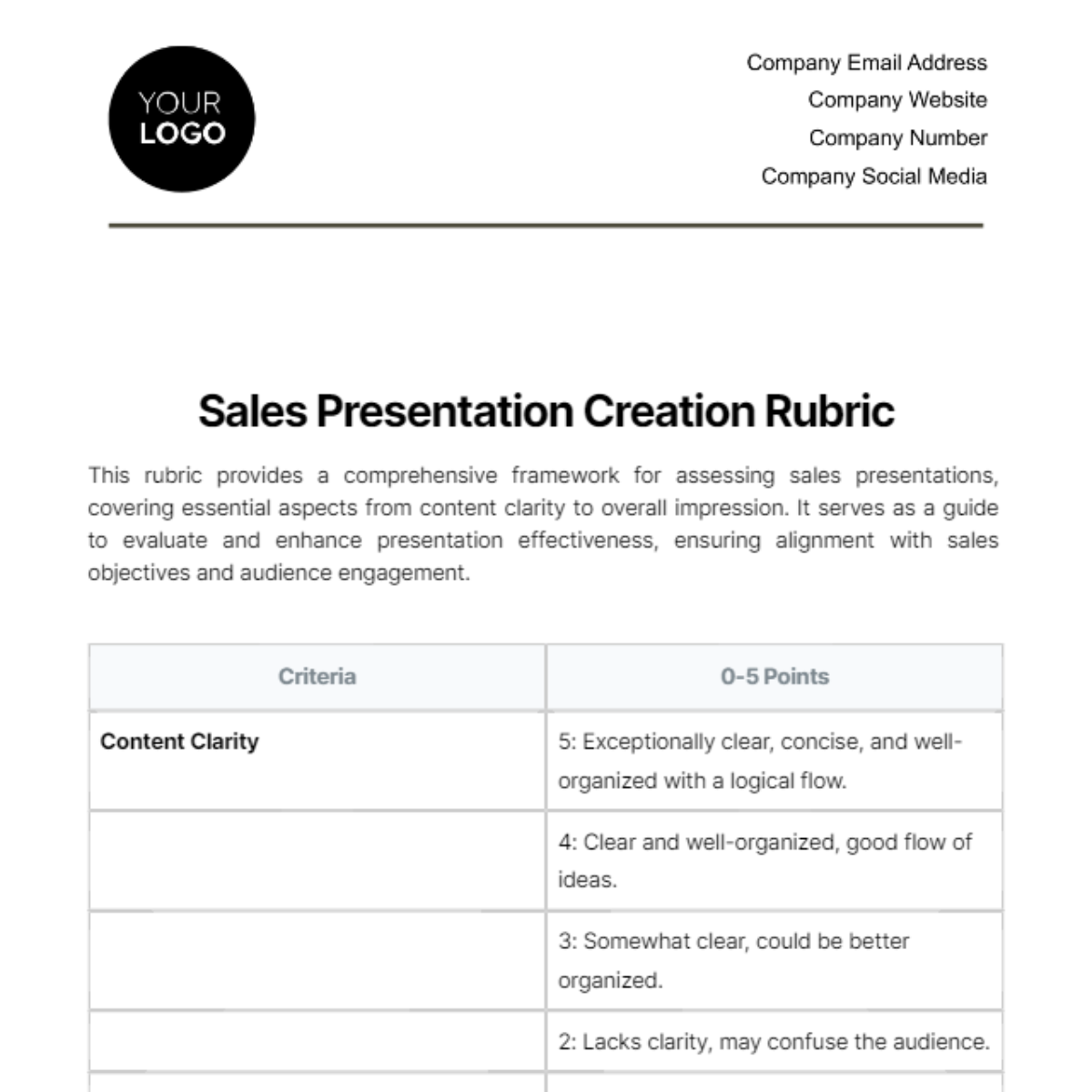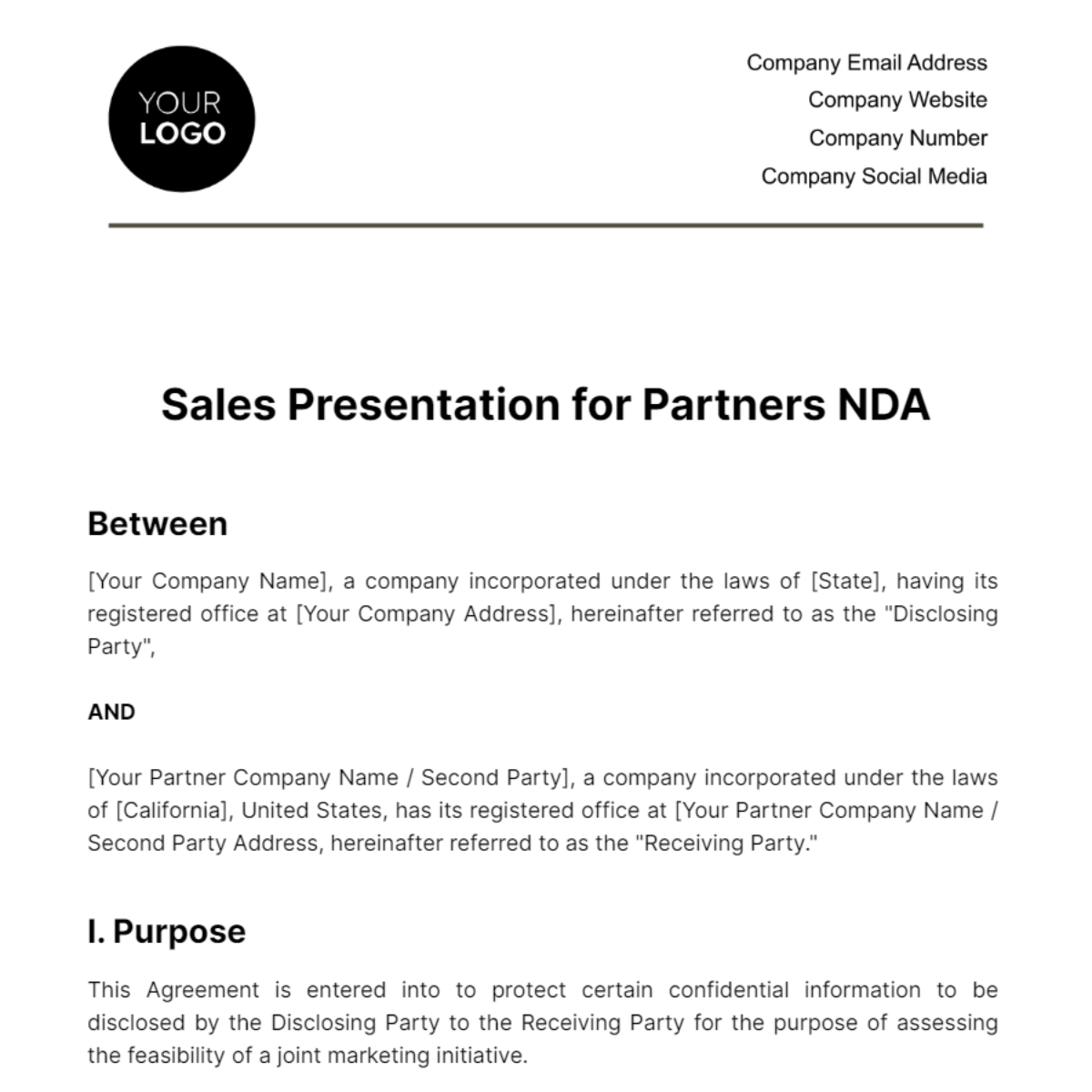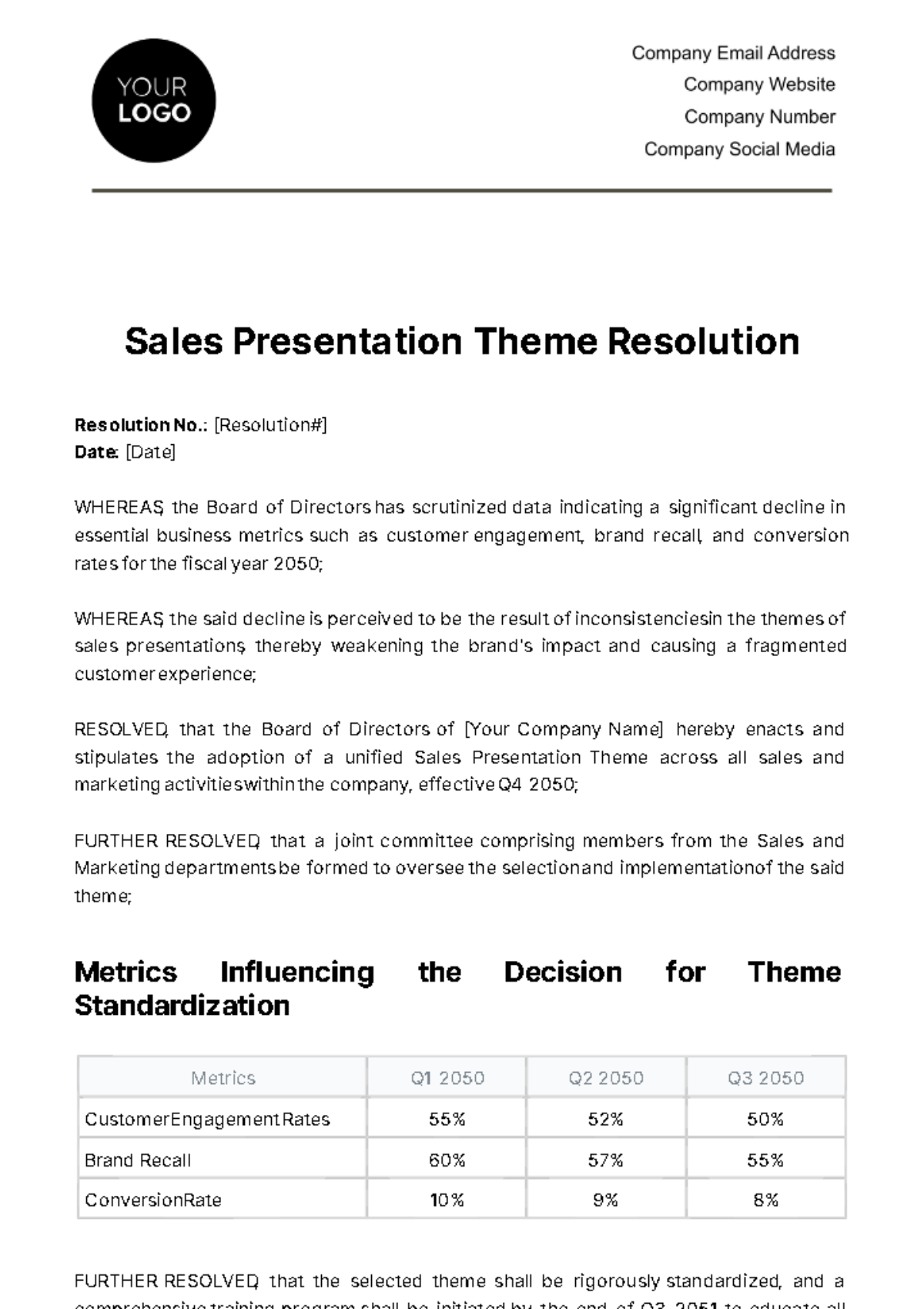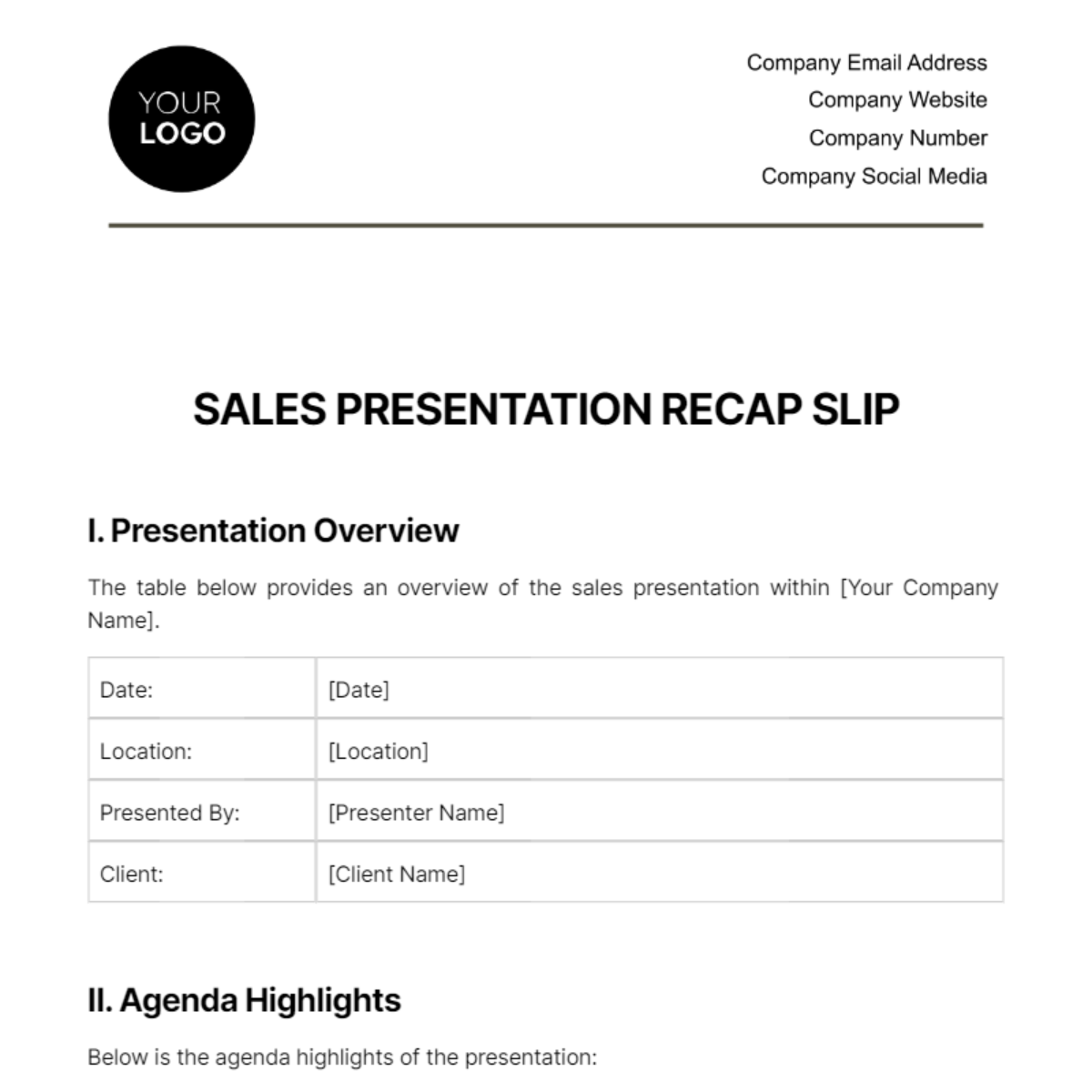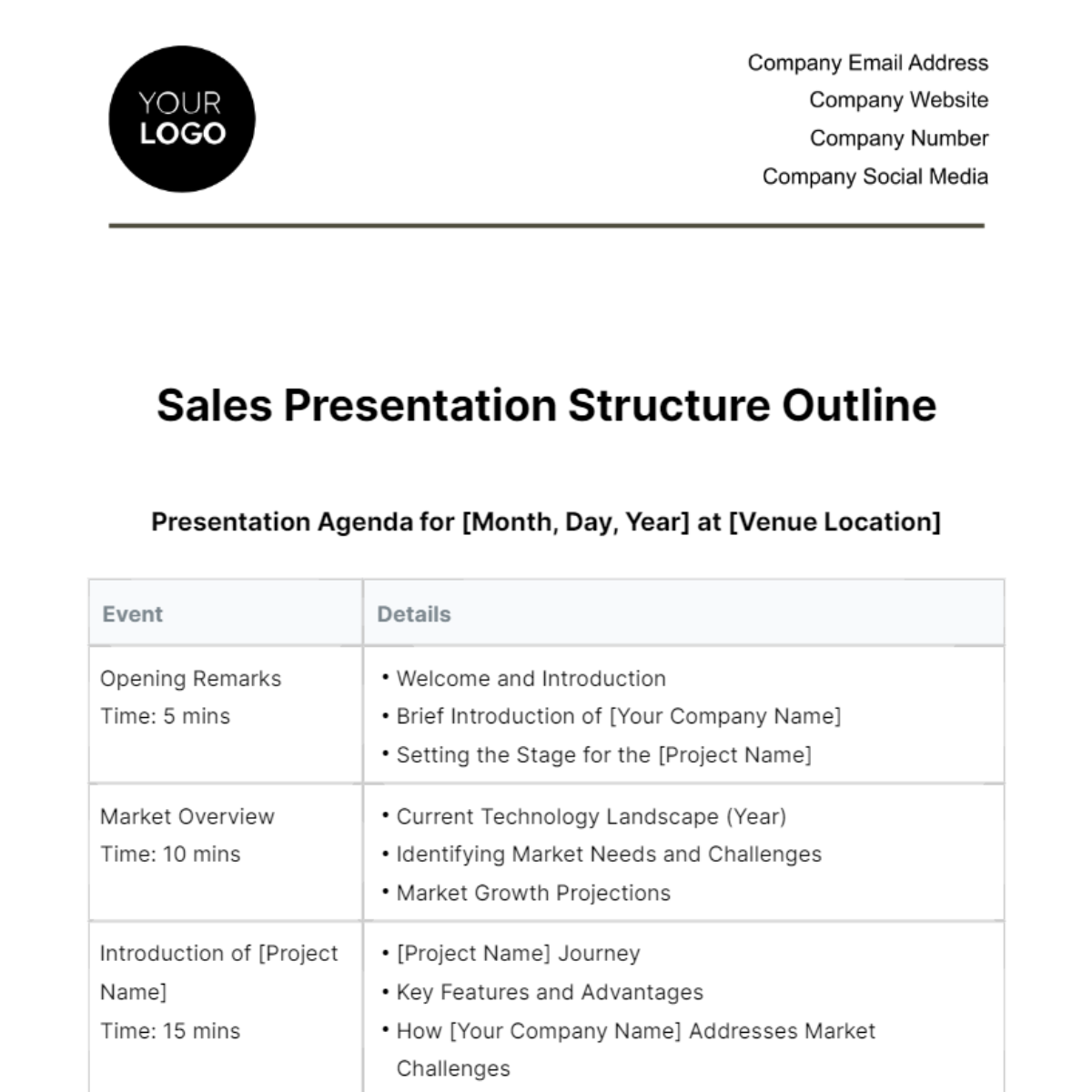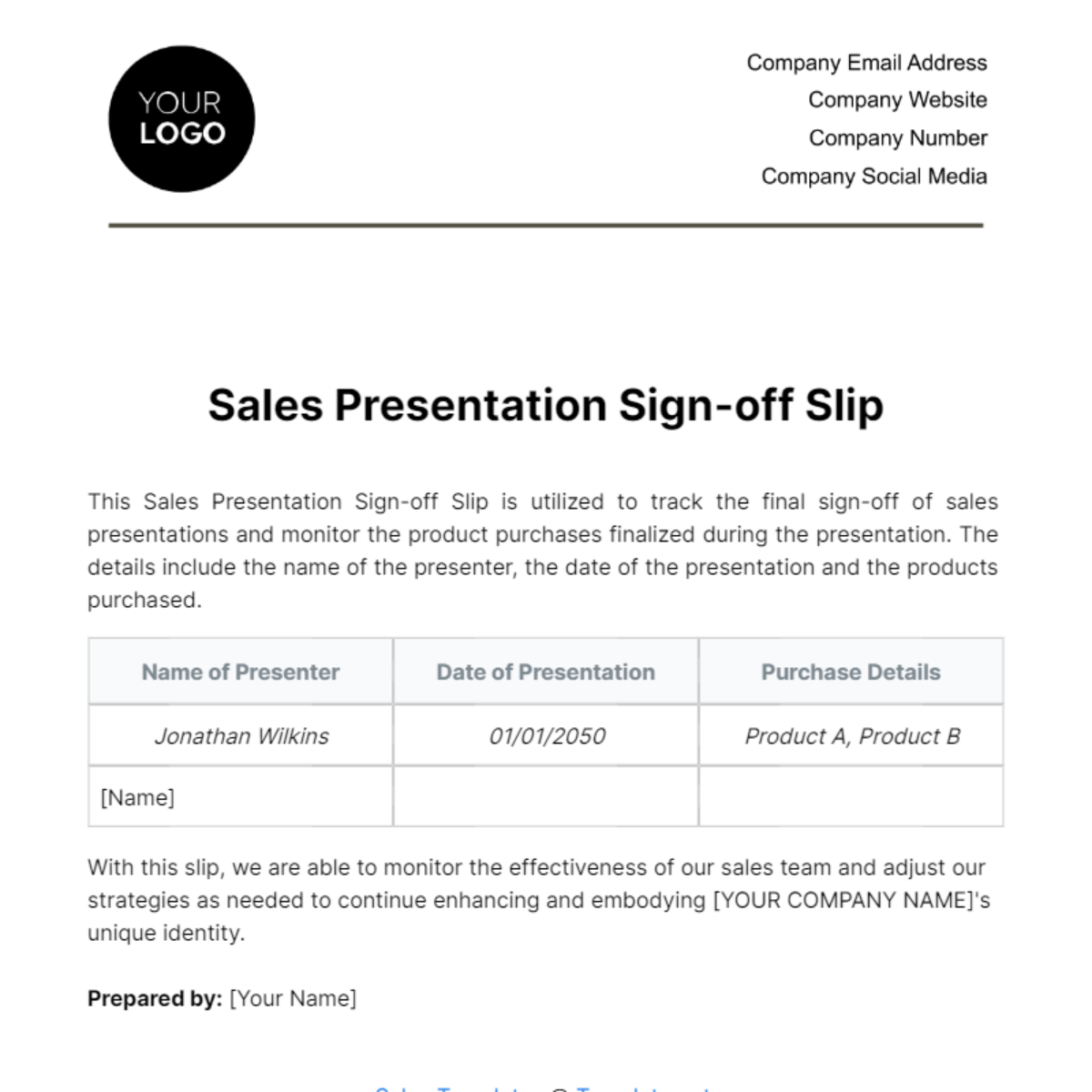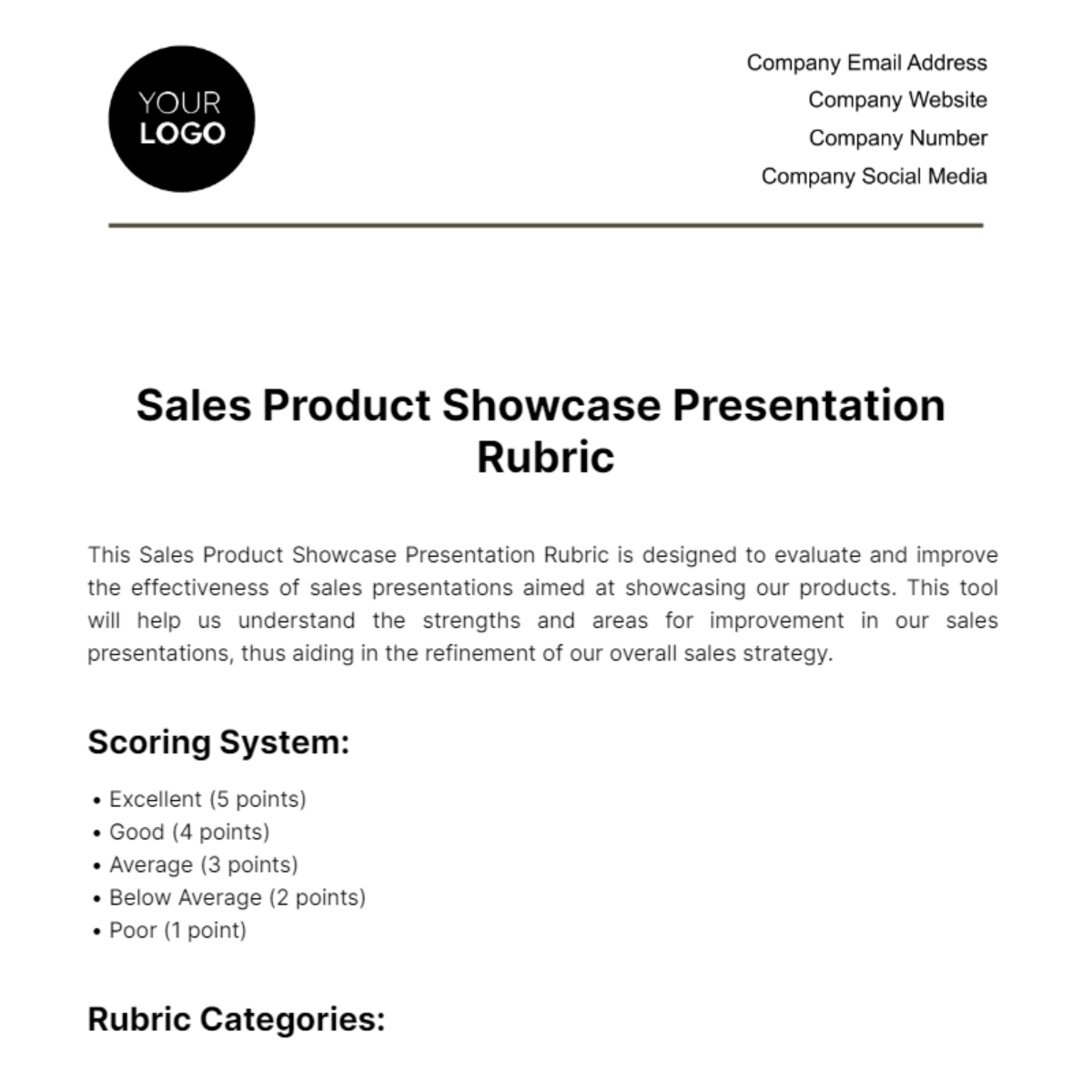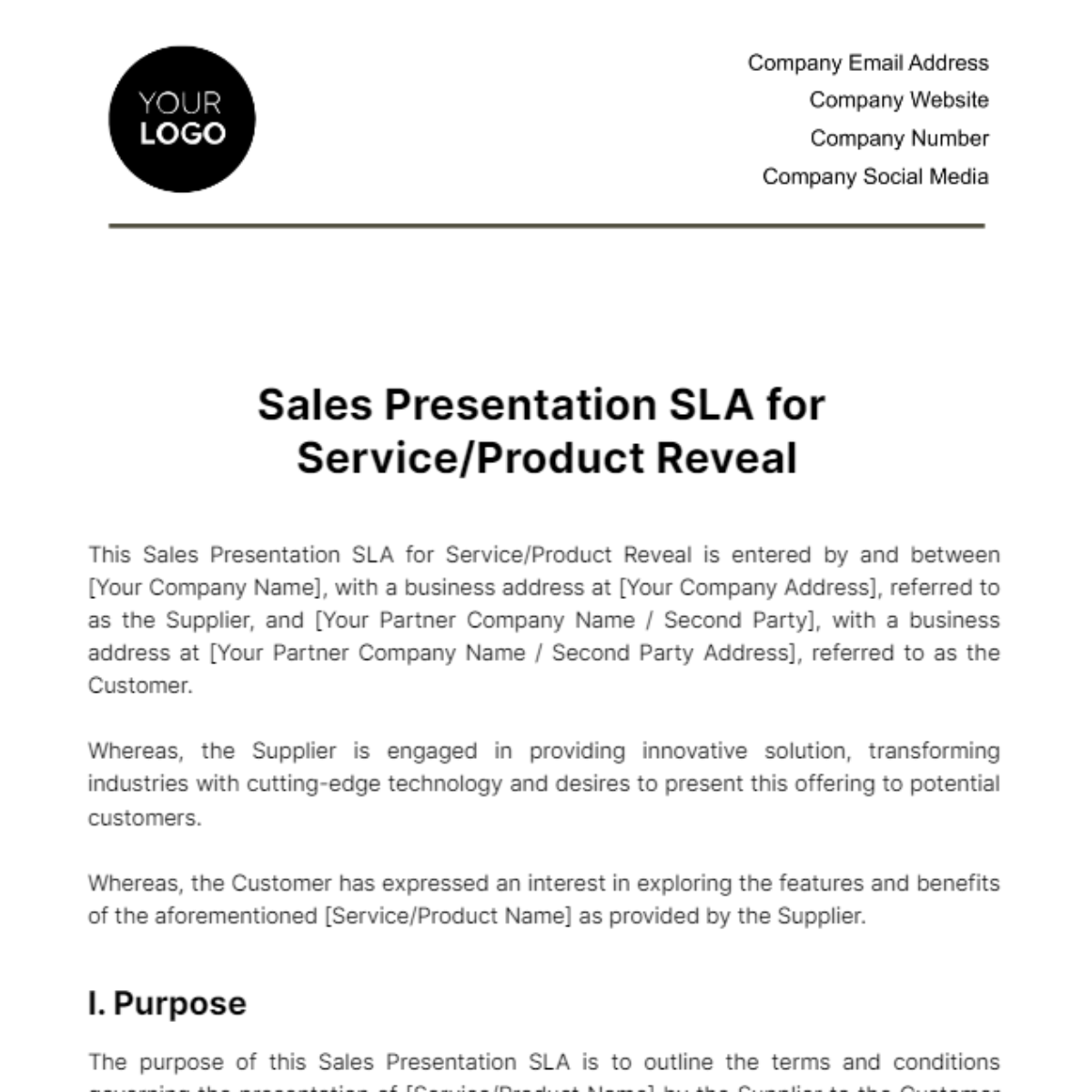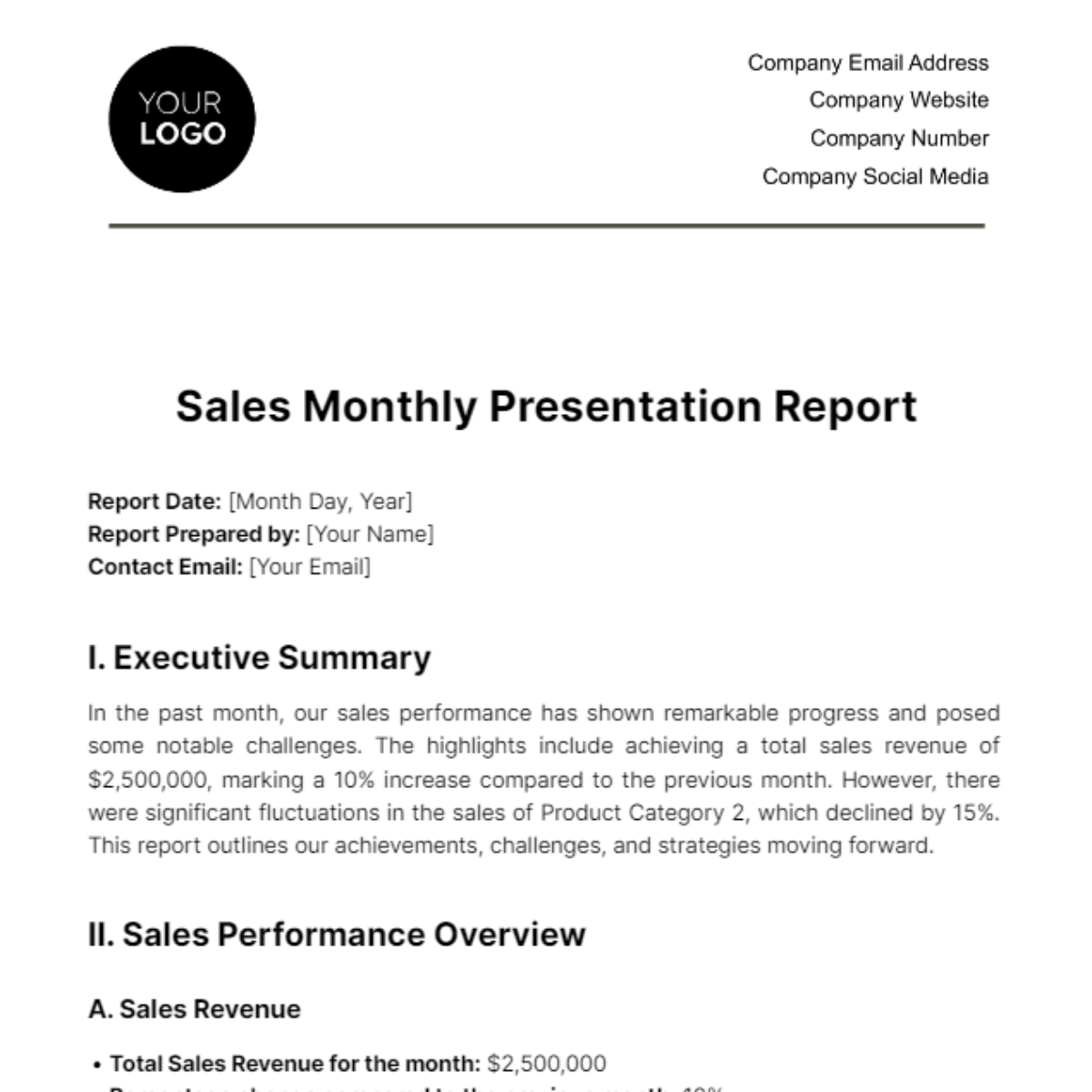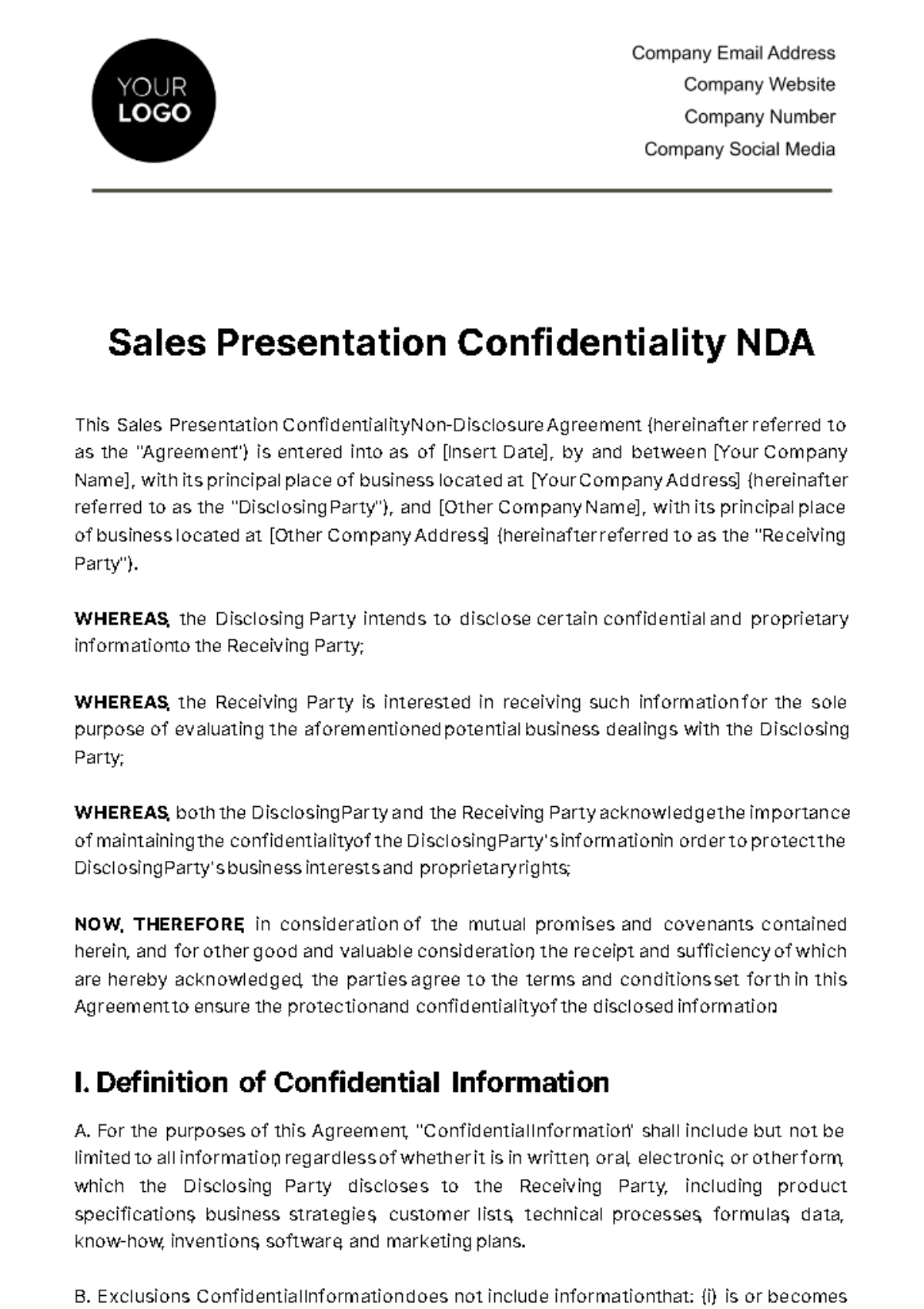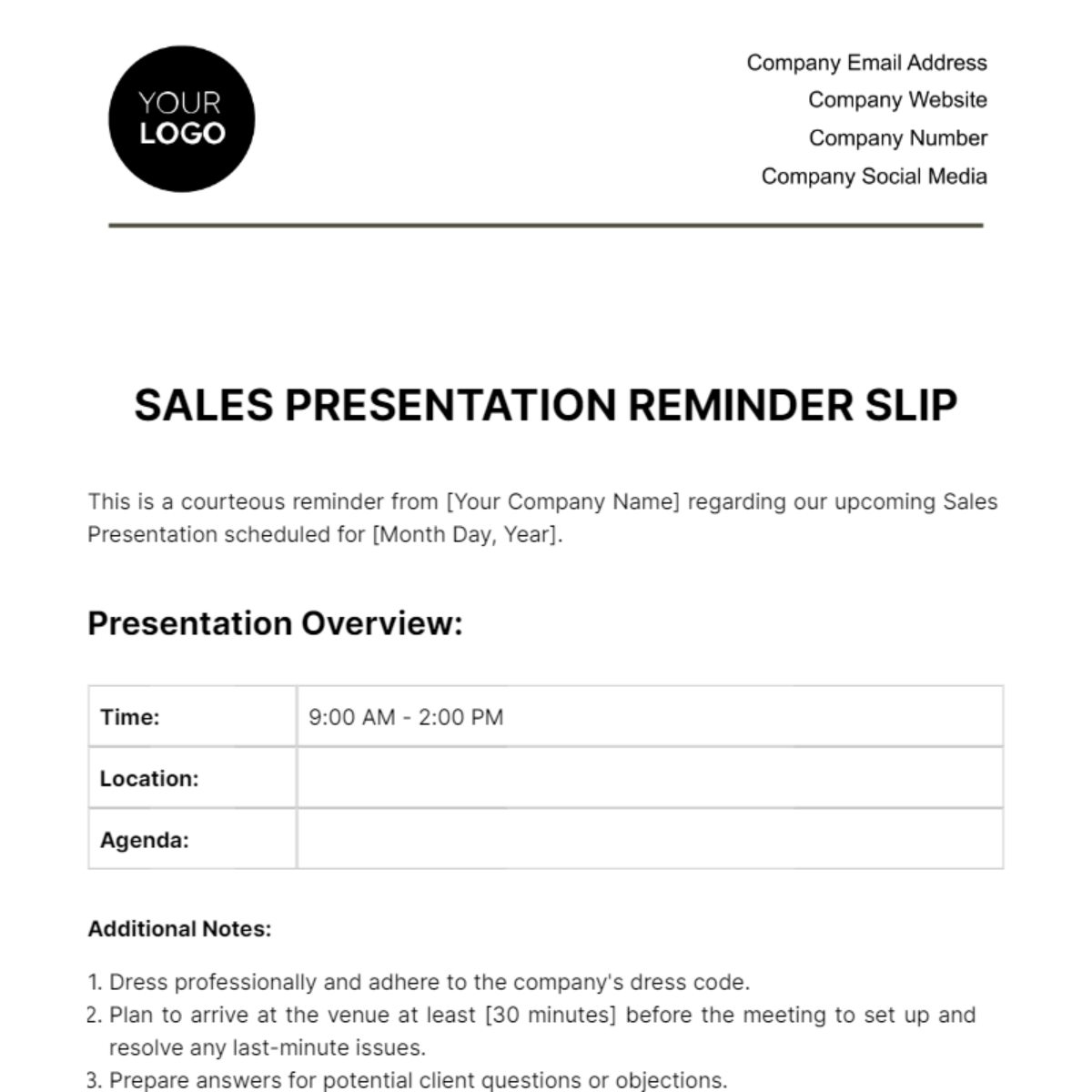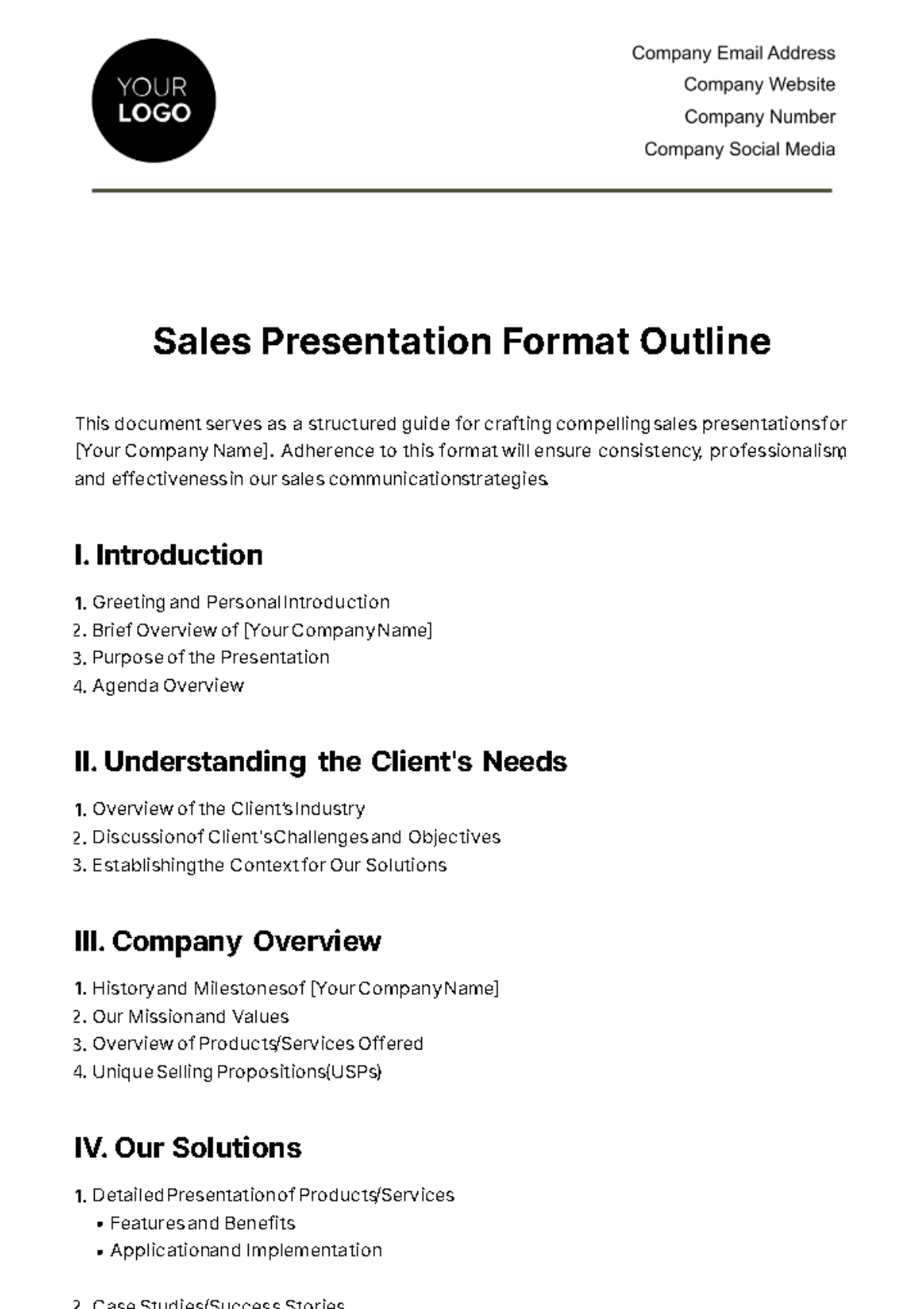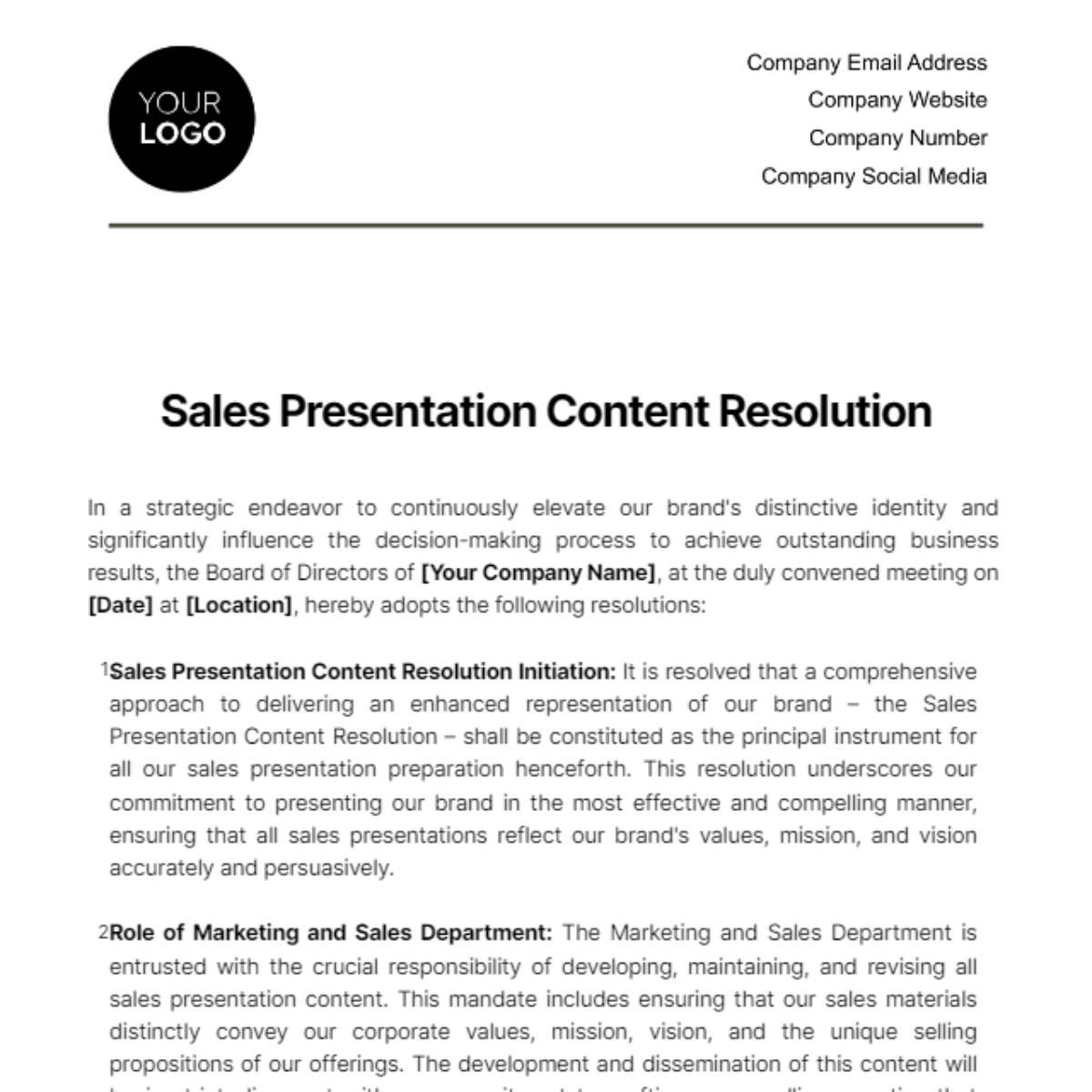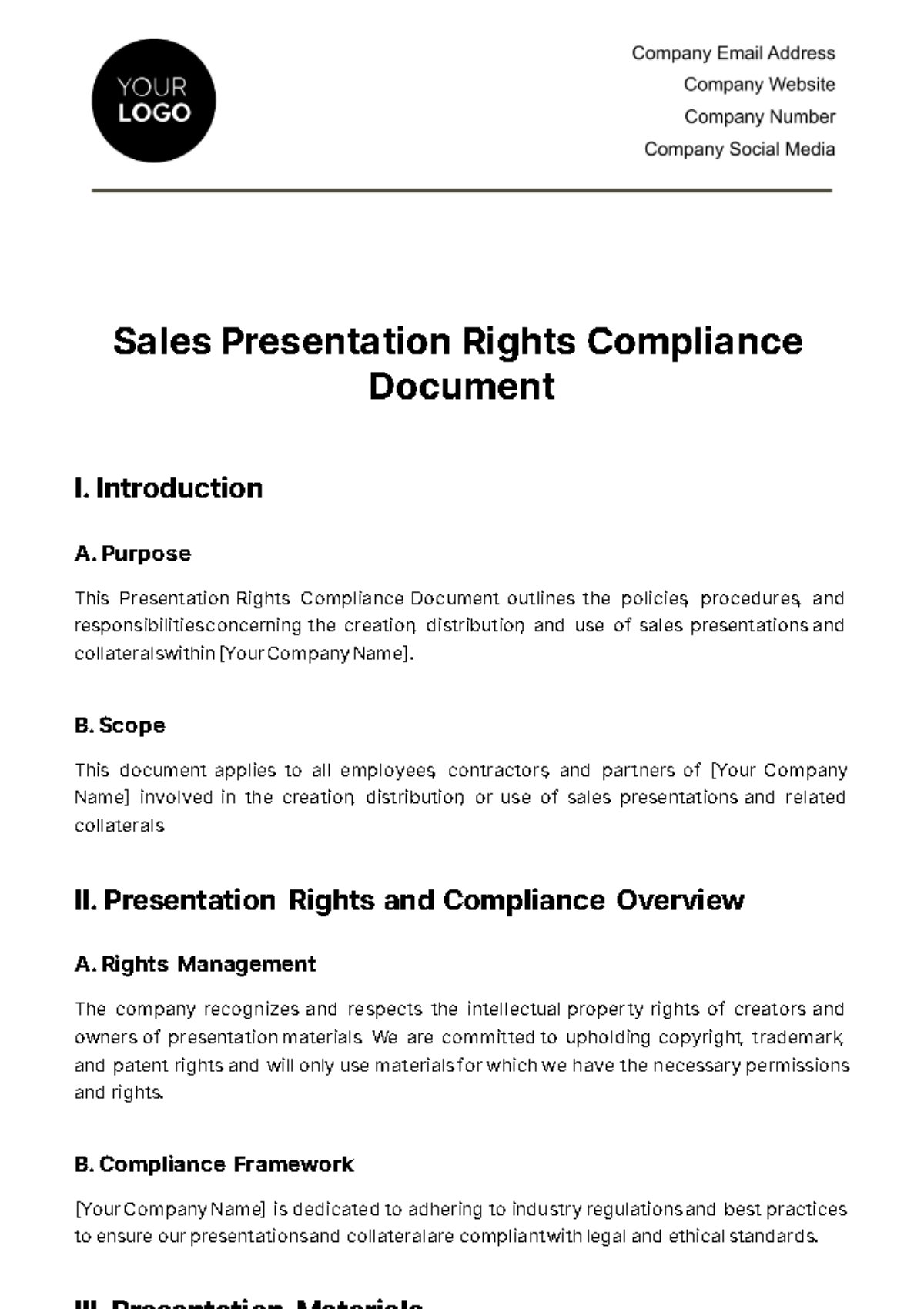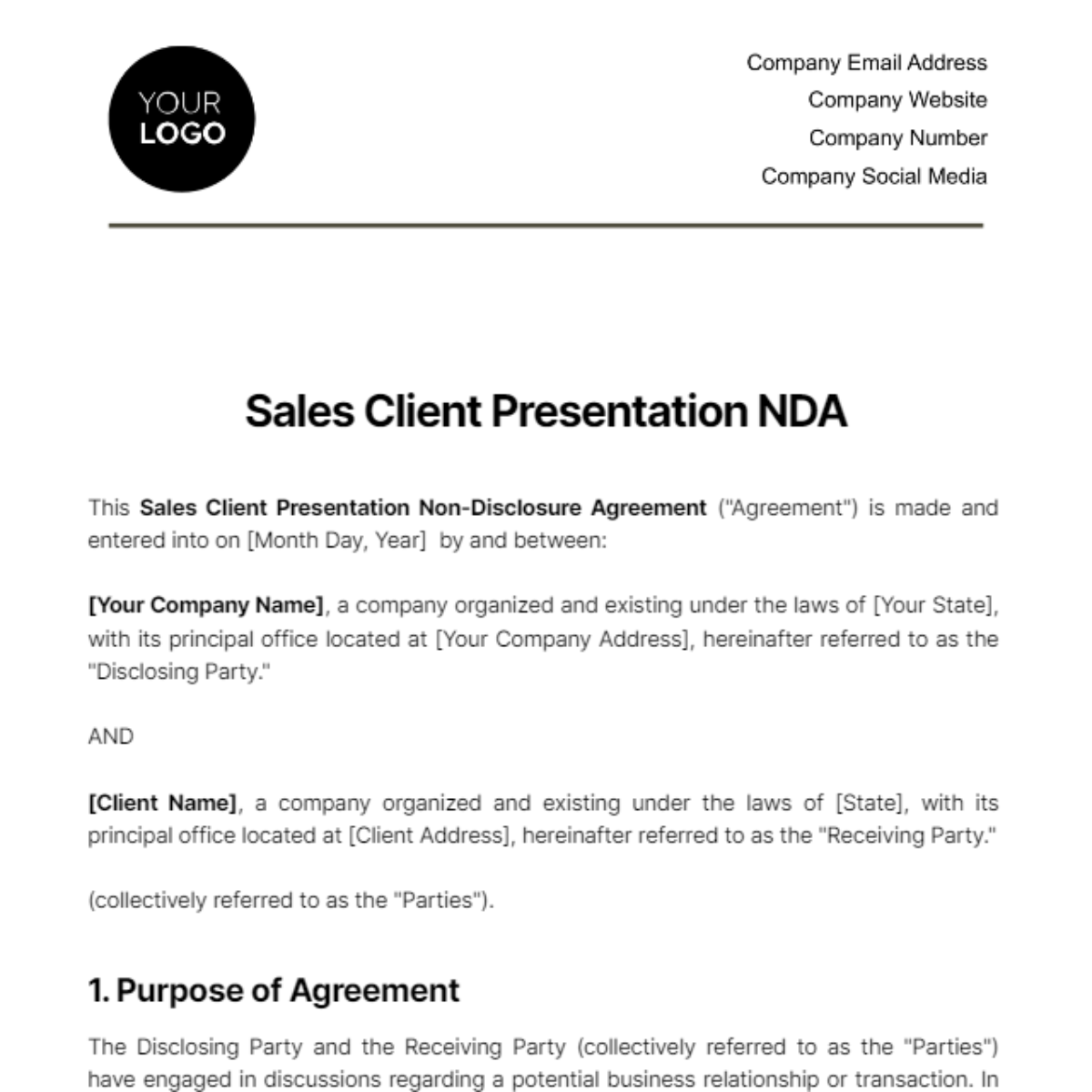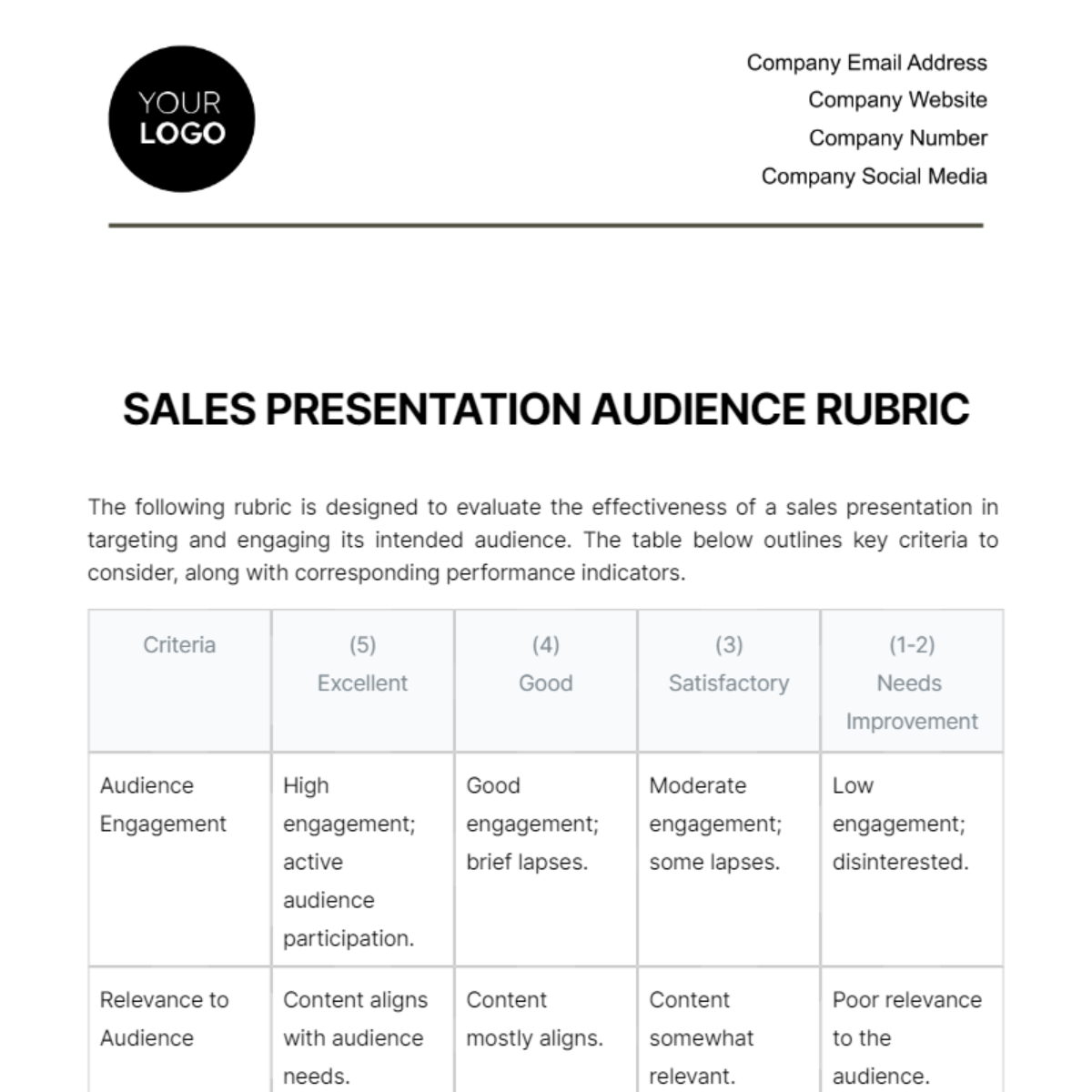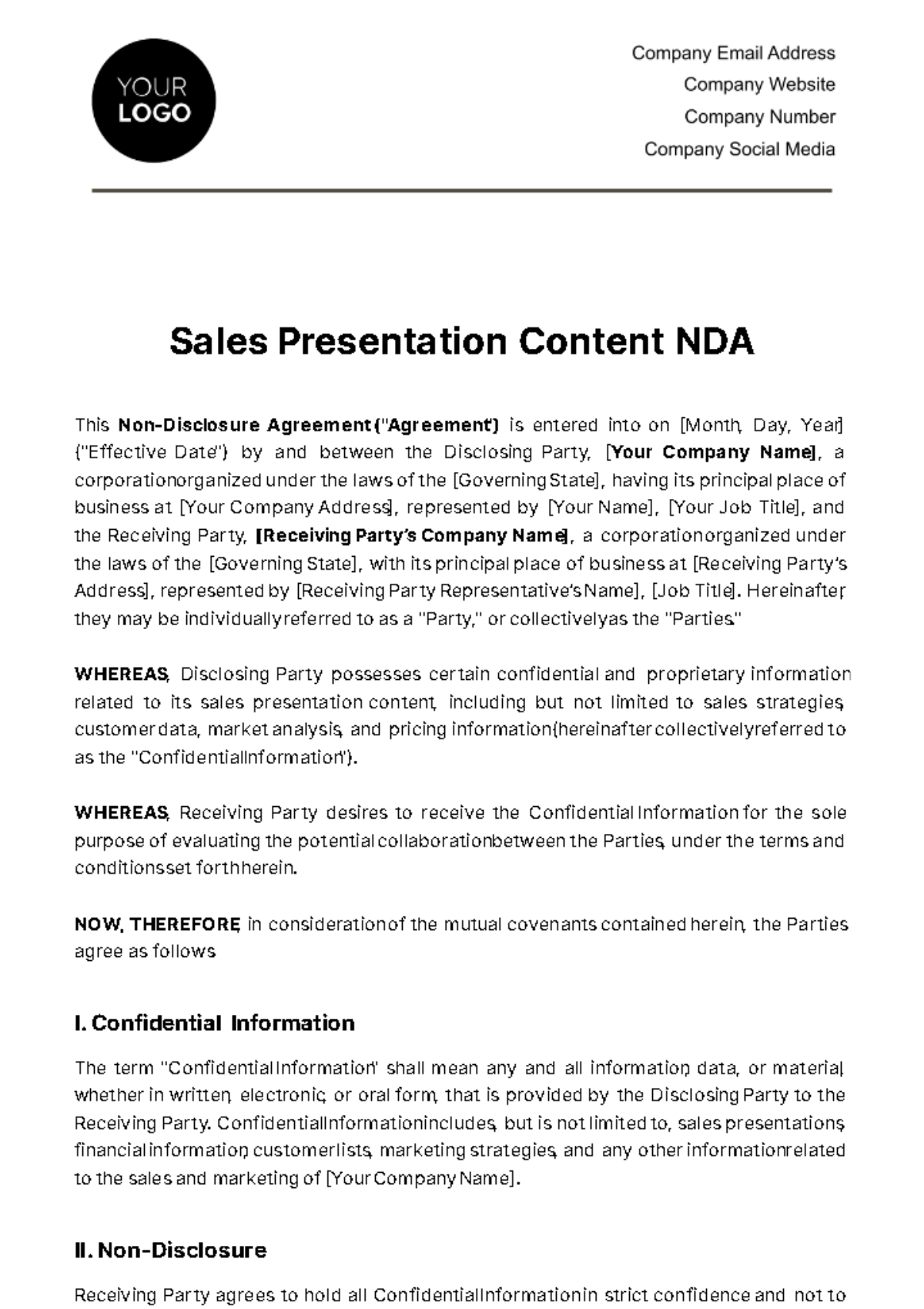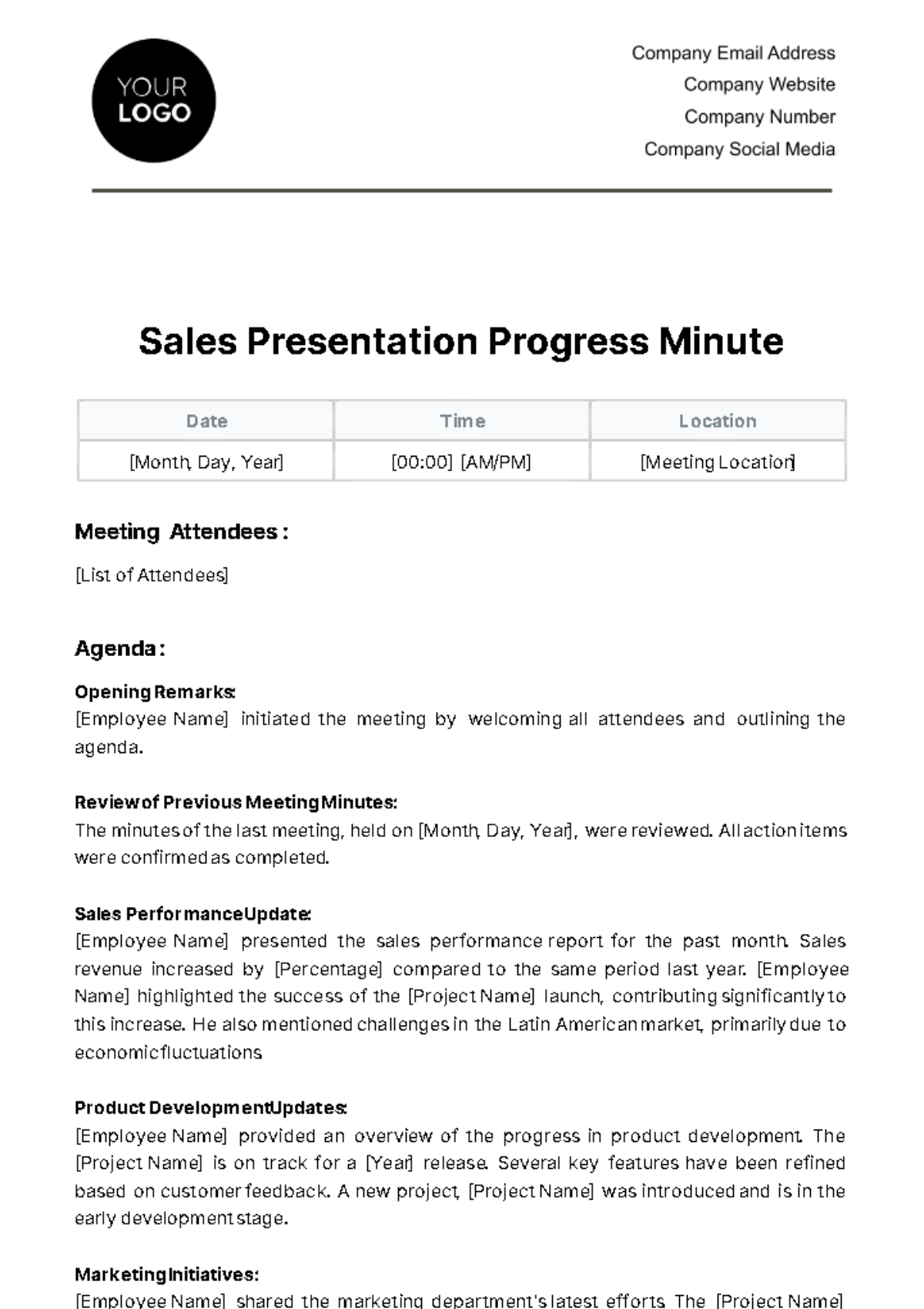Sales Presentation Content Portfolio
1. Introduction
Welcome to [Your Company Name]'s Sales Presentation Content Portfolio for the year [Year] and beyond. In today's fast-paced, highly competitive market, the role of compelling and impactful sales presentations cannot be overstated. A well-crafted presentation can be the deciding factor in establishing a strong connection with potential clients, fostering trust, and ultimately, closing a sale. However, the absence of a centralized system can lead to inconsistencies in messaging, design, and quality across different teams and departments.
To address this, we have meticulously designed this portfolio as a definitive guide to standardize the creation, usage, and distribution of all sales-related presentation materials. Whether it's slide decks that captivate, whitepapers that inform, or multimedia content that engages, this portfolio provides a structured approach to make each presentation a winning one. Our aim is to elevate the standard of our sales presentations, thereby enhancing customer engagement and improving conversion rates.
By centralizing all sales presentation resources in one place, we intend to make the process more efficient for our teams. This not only aids in maintaining brand consistency but also allows us to measure effectiveness through key performance indicators (KPIs), enabling continual improvement. We trust that this portfolio will serve as an invaluable resource for everyone involved in the sales process at [Your Company Name].
2. Objectives
The objectives of this Sales Presentation Content Portfolio are multifold, each designed to align with the overall sales and marketing goals of [Your Company Name]. By establishing these objectives, we aim to instill a level of standardization and excellence that will carry through all our sales efforts. Here's a detailed look at each objective:
2.1 To Provide a Unified Resource for All Sales Presentation Materials
The first objective is to offer a centralized hub for all sales presentation materials, be it slide decks, case studies, or other multimedia assets. Having all these resources in one place will make it easier for sales teams to find the tools they need, thereby reducing time spent searching for materials and ensuring brand consistency. A unified resource eliminates the risk of outdated or off-brand materials being used in presentations.
2.2 To Improve the Effectiveness of Sales Presentations
Our second objective is aimed at the quality of the presentations themselves. We intend to raise the bar when it comes to the content, structure, and visual elements of each presentation. Through rigorous guidelines, templates, and checklists provided in this portfolio, sales teams will be equipped to craft presentations that not only inform but also engage and persuade. Over time, this should contribute to higher conversion rates and more successful sales outcomes.
2.3 To Track and Measure the Success of Sales Presentations
Last but not least, it’s critical to measure the impact of our presentations to continually refine our approach. Hence, our third objective focuses on tracking and measurement. By implementing Key Performance Indicators (KPIs) and regular review mechanisms, we can assess the effectiveness of each presentation. This data-driven approach will offer valuable insights into areas for improvement and help us make data-informed decisions for future initiatives.
By meeting these objectives, we are confident that [Your Company Name]'s Sales Presentation Content Portfolio will serve as a cornerstone in our sales strategy, boosting both efficiency and efficacy.
3. Portfolio Items
The Sales Presentation Content Portfolio is segmented into three primary categories: Slide Decks, Supporting Documents, and Multimedia Content. Each of these categories plays a specific role in our sales process and targets a particular audience. Below, we provide details on what items are included in each section, their objectives, and which department is responsible for updating them.
3.1 Slide Decks
The slide decks serve as the backbone of our sales presentations. They are usually the first point of contact between the sales team and the customer, making them crucial for creating the right impression.
Topic | Objective | Target Audience | Responsible Department | Last Updated |
|---|---|---|---|---|
Product Overview | To inform | General | Marketing | Jan 1, 2050 |
Case Studies | To persuade | Potential Clients | Sales |
Product Overview: This deck aims to inform the general audience about the core features and benefits of our products. The Marketing department keeps this updated, with the last revision in [Date].
Case Studies: Tailored to persuade potential clients, these decks showcase successful implementations of our solutions. The Sales department is responsible for keeping these up-to-date, with the most recent update in [Date].
3.2 Supporting Documents
These documents serve to complement the slide decks by providing in-depth information that can help in the decision-making process.
Type | Objective | Target Audience | Responsible Department | Last Updated |
|---|---|---|---|---|
Whitepapers | To educate | Technical Decision Makers | Marketing | |
Pricing Sheet | To inform | Financial Decision Makers | Sales |
Whitepapers: Created with the aim of educating technical decision-makers, whitepapers provide comprehensive insights into our technology and solutions. The Marketing department maintains this content, with updates as recent as [Date].
Pricing Sheet: This document informs financial decision-makers about the cost structure of our solutions. Updated by the Sales department, the latest revision was made in [Date].
3.3 Multimedia Content
Multimedia content like videos and customer testimonials adds a dynamic element to our sales presentations, providing visual and emotional context.
Type | Objective | Target Audience | Responsible Department | Last Updated |
|---|---|---|---|---|
Product Videos | To engage | General | Marketing | |
Customer Testimonials | To persuade | Potential Clients | Sales |
Product Videos: Intended to engage a general audience, these videos offer a visually stimulating tour of our product offerings. The Marketing department keeps these up-to-date, with the most recent addition in [Date].
Customer Testimonials: Aimed at persuading potential clients, these testimonials offer firsthand accounts of customer satisfaction. Managed by the Sales department, the latest testimonial was added in [Date].
By keeping each of these portfolio items up-to-date and aligned with their respective objectives, we ensure that our sales teams are well-equipped to succeed in a range of scenarios.
4. Audience Segmentation
Understanding the specific needs and preferences of various audience segments is crucial for the success of any sales presentation strategy. In this section, we delve into our primary audience types: Small and Medium-sized Businesses (SMBs) and Enterprises. By identifying the unique pain points and content preferences for each group, we aim to tailor our sales presentations and collateral more effectively, thus ensuring higher engagement and conversion rates.
Audience Type | Pain Points | Preferred Content Type |
|---|---|---|
SMBs | Budget Constraints | Slide Decks, Whitepapers |
Enterprises | Complexity | Multimedia Content |
SMBs: Small and Medium-sized Businesses often operate with tight budgets, making cost a significant concern for them. They prefer straightforward, value-focused content that they can quickly understand and act upon. Slide decks that lay out the value proposition and whitepapers that offer in-depth insights into cost-effective solutions are most effective for this segment.
Enterprises: These are large organizations that often deal with complex infrastructures and diverse needs. They seek content that can clearly demonstrate how a solution fits into their complex ecosystems. Multimedia content like videos and interactive demos are generally more effective in explaining complex scenarios and are thus preferred by enterprise-level clients.
By segmenting our audience in this manner, we can create targeted and effective sales presentations, ensuring that the right message reaches the right people.
5. Usage Guidelines
Effective sales presentations require not just compelling content but also consistency in messaging and appearance. This is vital for brand integrity and for ensuring that the presentations meet the company's quality standards. Below are the guidelines that all sales representatives must follow when using the Sales Presentation Content Portfolio.
Adherence to Content Structure: All sales representatives are expected to adhere strictly to the content structure outlined in this portfolio. This structure has been carefully designed to optimize the flow of information, make the presentations engaging, and maximize conversion rates. Deviating from this structure could lead to inconsistencies and dilute the effectiveness of the presentation.
Customization Approval: We understand that sales reps may sometimes need to customize presentations to better suit specific client needs or scenarios. However, any and all such customizations must be pre-approved by the marketing department. This is to ensure that the customizations are in line with the company’s branding guidelines and messaging strategy.
By following these usage guidelines, we aim to standardize the quality of our sales presentations across the board, thus ensuring that every potential client receives a presentation that is not only informative but also consistent in quality and messaging.
6. Metrics and KPIs
To continuously improve the effectiveness of our sales presentations and to understand the return on investment they offer, it's crucial to track certain metrics and Key Performance Indicators (KPIs). Below is an overview of the metrics we use to measure the success of our sales presentations:
Metric | KPIs | Description |
|---|---|---|
Engagement | Time Spent, Click-through Rate | Engagement is a crucial metric that measures how well the audience interacts with the presentation. Time spent indicates how long viewers are staying on each slide or video, which in turn shows the depth of their interest. The click-through rate (CTR) measures the percentage of viewers who interact with actionable elements in the presentation, such as embedded links or call-to-action buttons. |
By regularly reviewing these metrics and KPIs, we can make data-driven decisions that enhance the effectiveness of our sales presentations. This, in turn, will help us achieve our overall objectives of improving customer engagement and increasing conversion rates.
7. Review Schedule
To ensure the ongoing effectiveness and relevance of our Sales Presentation Content Portfolio, it's essential to have a structured review schedule. This schedule will not only help us assess the effectiveness of our portfolio but also make timely adjustments to meet emerging market demands. The schedule is broken down into quarters of the year [Year], each with a specific milestone that aligns with our objectives.
Quarter | Milestone | Description |
|---|---|---|
Q1 2050 | Initial Rollout | During the first quarter, we will focus on the initial rollout of the Sales Presentation Content Portfolio. This involves disseminating the portfolio to all relevant departments, conducting training sessions to familiarize teams with the guidelines, and gathering initial feedback for any immediate adjustments. |
